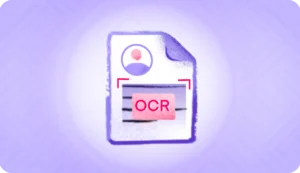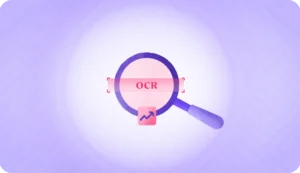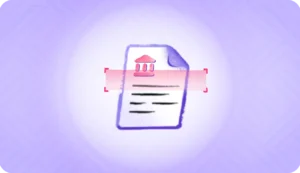OCR, or Optical Character Recognition, is arguably one of the most vital software used by businesses today. As per a recent study, over 46% of employees spend their valuable time on inefficient clerical tasks that this technology can take care of easily.
OCR software is like an automated solution that turns extracted and unstructured data into readable and structured formats that can be processed easily by humans. It replaces a lot of unproductive work with more productive and efficient work.
With the advancements in technology and deep learning, OCR is likely to facilitate the capabilities brought by AI to the business world and has been transforming how data is extracted, used, and processed across different business functions.
Without effective OCR software in place, it is possible to store and retrieve files, but the data would still be unreadable and not of much use. The OCR software scans the document to extract data and recognize letters from images, converts them into structured data, and assembles them into words and sentences that make it easier for businesses to edit, use, and reuse the required information. These documents include Word, PDF, Excel, and other text formats. However, this can be limited to password-protected documents containing classified or sensitive information.
OCR data extraction is the process of extracting data through optical character recognition technology that helps to create usable documents by extracting useful information from documents or photos containing texts as images. This process helps to convert images into a machine-readable format that reduces a lot of manual effort. It includes scanning images, documents, stats, or reports in image format that are difficult to extract from scanned documents.
Why is OCR data extraction important for businesses?
Optical Character Recognition is essential for any business to replace grunt work done by employees with machines using information in real-time. From law firms to banks, healthcare centers, security providers, advertising, and other public and private sectors, optical character recognition technology is used across many sectors around the globe. Read on to know how it impacts businesses:
Enhancing data accessibility and searchability
OCR software uses advanced algorithms to recognize letters from image files and combine them into a readable format. This helps to increase data extraction, accessibility, and searchability in any business process and replaces lengthy manual data entry with a single click.
Improving data accuracy and efficiency
OCR data extraction software replaces manual data entry with automated data extraction that reduces the chances of human typo errors and delivers structured data for better functioning. It also automates the workflow streamlining across departments, increasing data accuracy and efficiency.
Enabling automation and digitization of paper-based documents
OCR systems are fast, accurate, and more reliable when handling data extraction or data entry needs. It helps businesses convert their processes into digital formats and adopt automation for quicker and more effective operational efficiency.
Compliance with regulatory requirements like AML (Anti-Money Laundering) and KYC (Know Your Customer)
KYC (Know Your Customer) and AML (Anti-Money Laundering) are critical functions to any business for staying compliant and assessing the legal requirements of any process requirement. It can be risky and costly if not done right. Manual data entry has a higher chance of errors. On the other hand, OCR systems can be highly beneficial in increasing the efficiency of tasks and processes related to KYC or AML in any business.
How does OCR data extraction work?
OCR data extraction works on algorithms that help recognize and convert unstructured text into a structured and readable format. Latest technological advancements have made data management more efficient and easy. Various companies offering OCR data capture services provide effortless data extraction from scanned images and documents in over 200 languages. Let’s look at different methods of OCR data extraction.
Different methods of OCR data extraction
Pattern Recognition: This method works by isolating different types of fonts in a specific shape, design, or typeface called glyph. The software uses pattern-matching algorithms to perform data extraction using optical word recognition. It works effectively when extracting information from scanned documents having different fonts or handwritten text.
Feature Detection: The OCR tool uses a feature extraction algorithm to identify different characters or features of text, including angled lines, crossed lines, or curves used for comparing and identifying characters and meaningful information.
Machine learning algorithms: Machine learning algorithms are trained on various datasets to identify characters, scan legal documents having text images, and use complex formatting to identify document content and convert files into structured and readable formats. These files can be accessed in Word, PDF, or Excel format easily.
Step-by-step process of OCR data extraction
Scanning or Pre-processing: In the initial step of scanning any document, the system prepares the files by enhancing their image quality, so it is easier for the computer vision to scan the document with more clarity and aid in effective text extraction.
Format and content detection: In the second step, a specific configuration is needed to detect the format, making it easier for the OCR engine to extract text and convert the document into an editable format. Any image smaller than 16 x 16 pixels or larger than 8400 x 8400 is undetected by an OCR engine.
Character recognition: In this stage, the algorithms analyze the characters, words, and other textual elements through different paper forms, readying them for human validation. Text recognition is made easier by the algorithms that help convert unstructured documents into readable and structured formats.
Post-processing: The OCR system uses techniques like Lexicon, Natural Language Processing (NLP), and intelligent character recognition that help increase data accuracy and get proper document analysis towards the end of the process. This step also includes proofreading the documents and eliminating any possible grammatical or spelling errors that can cause an issue later.
Output: The most commonly used formats for the output of an OCR file include PDF, DOC, TXT, HTML, and CSV. Out of these, PDFs are the most widely used formats for OCR output, as they are easy to create, the most compatible, and highly searchable formats on the web.
HyperVerge’s OCR data extraction
Accuracy and Reliability
We have an AI-powered, template-agnostic OCR engine with over 90%+ accuracy and the capability to scan data from any document around the globe. We deliver consistent performance across different document types with high precision and offer seamless OCR solutions for unstructured and multilingual document processing using our AI-powered Optical Character Recognition technology. With consistent AI training and improvements in OCR algorithms, we offer excellent OCR for documents like driving licenses, government ID cards, insurance documents, legal documents, and more. Also, read about how OCR data extraction can further streamline the process of extracting and structuring data from various document types in our blog on OCR data extraction.
Scalability and Flexibility
With an ability to handle large volumes of documents, we have been helping startups and the world’s leading companies in extracting text from different kinds of documents and creating an internal database that is secured and highly confidential. We help them streamline business processes, digitize and automate processes, perform data mining at different levels, and help document classification in a much more organized manner. Our AI can train on minimal data for new documents, which has increased our adaptability to scan unstructured data and convert it into readable structured files and give the desired outputs.
We manage audit trials of every application used in the process and offer seamless integration with existing systems for better performance and security.
Conclusion
Data extraction is a need for businesses of all sizes. It’s time to automate it with a template-agnostic OCR and ID verification engine. With new technologies like AI, OCRs are now capable of intelligent processing and error-free data extraction. A highly advanced solution like HyperVerge can improve your overall business efficiency. Sign up today and get started with the safest OCR technology with the highest accuracy rates.






